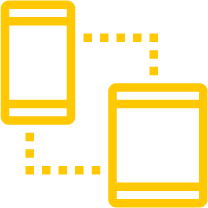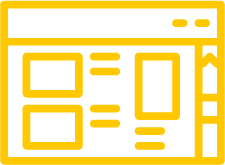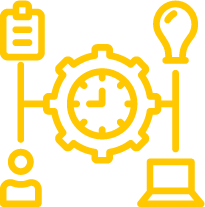#1.
Introduction
Developing a mobile application is a big project and requires a lot of preparation.
One of the documents you should have finished before you start is a specification, which is a document that contains comprehensive information about your mobile application and serves to define your project.
The purpose of this document is to fully understand your needs and expectations so that you can develop the best possible solution.
In this article, we explain which elements are important to include in the specifications so that they provide the best possible guidance for your project manager.
At the end of the article, you will find a sample specification to download.
#2.
Our advice before you get started
The specification is not always considered by all IT development companies as a strict document that must be followed to the letter.
For example, at Deuse, the specification helps us create 'User Stories' (description of a functionality of your application from the user's perspective), and we develop everything that is included in them.
In our case, these User Stories serve as the reference document to follow. If certain points in the specification are not found in the User Stories, they will not be developed.
So it is very important to determine, together with your project manager, the document to be followed for the development of your mobile application to ensure that you are on the same page and to avoid unpleasant surprises.
A specification doesn't need to be long; the explanation should be concise. The goal is to simplify the work of your project manager, not to complicate it.
In general, you should not go into too much detail about the functionalities or the design you want for your application to avoid overly restricting the developers. You should leave them some room for maneuver.
Writing your specification comes into play when you are confident enough in your idea.
If you are not far enough along in your project, we recommend waiting.
For example, if you are 70% sure of your idea, you run the risk of changing your mind very often between the time you write your specification and the development of your mobile application. This can lead to a large number of changes and shorten the development time, with the risk that the developed solution may not fully meet your needs.
If you are at the beginning of your mobile application project, we invite you to read our article "How to properly prepare and manage your digital project as a client?" to discover best practices so that the development proceeds as smoothly as possible.
#3.
Important elements to include in your specifications
Here are the various elements that we believe make a good specification:
Project Description:
A brief description of the concept of your mobile application is sufficient; you don't need to go into the smallest details.
The goal is to define the scope of your project (what, why, how), the target audience (user profile), what you want to achieve, and the primary purpose of your mobile application (objectives and added value).
You can explain the current context and why you are engaging a project manager.
It is also very useful to explain your different workflows: how they should work and communicate with each other.
In this context, you can broadly describe your profession, the industry you work in, and the processes you use (if there are external devices or services involved in the project, it's important to provide their documentation/user manuals to your project manager).
If you already have an existing solution, do not hesitate to include visual materials in your product specification and ideally provide a demonstration to your project manager so that they can gain a precise understanding of your project and see possible optimizations for your future digital solution.
To assist developers, you should provide all documents related to your project.
For example: we are developing a tool for managing the scheduling of the medical imaging service of the Groupe Santé CHC. They sent us all the Excel files they use, so we have all the project information and a comprehensive understanding of the profession's specifications.
Without these documents, we would likely have missed important elements.
The same applies to equipment. If your existing solution, for example, requires hardware, such as a device that reads or transmits data, you should provide it to your service provider along with the product specification.
We want to empathize with our customers to understand them as best we can.
Finally, it's interesting to define your users: who will use your app? If you have different types of users, mention this, as the functionalities can vary by role.
List of Features:
List what users can do on your mobile application, for example: order items, purchase them, send messages, add friends, and so on.
It is necessary to distinguish between essential features for your application and secondary, "nice-to-have" features.
This is important because your budget may not allow you to develop all features initially. You'll need to prioritize essential features.
You must strike the right balance between what you want to achieve and what is technically possible and within your budget.
Don't forget to specify whether the site should be translated into multiple languages.This feature has implications for the construction of the mobile application. So, it's important to mention this at the beginning of the project.
Pages to Develop:
After thinking about the features, you can consider the different pages that will make up your mobile application.
Here are some examples: a home page, an account creation page, login, notifications, and so on, depending on the features of your application.
It's not a problem if you haven't thought of all the pages yet. Often, during discussions with your project manager, you'll discover which pages are missing.
Having an idea of the main pages and the structure of your application will greatly assist your project manager.
User Interface:
You have described the content of your application; now let's move on to its design.
You need to define in writing or visually the different content blocks of all your pages (text, images/videos, buttons, etc.), and this is called wireframes.
A wireframe is a diagram or plan of your future mobile application. It's a simplified version of your user interface that will allow you to visualize your project.
Here is an example of a wireframe:
Besides the pages, you can also define the connections between them to understand the navigation path of your users. When a user clicks a button, which page will they land on?
To visualize these connections, you can easily draw an arrow between the two pages. Everything should be sketched in a wireframe.
At Deuse, we organize a workshop at the beginning of the project where we create wireframes together with you.
Even when we create them, we appreciate it if our clients bring some wireframes or sketches with them, as it helps us to better understand what they want.
You can use tools like Figma and Invision or even just sketch by hand; both work equally well.
Design:
Now that we have a better idea of the content and layout of your application, we need to learn more about its design.
To get a better understanding of our clients' taste, we always ask them to provide us with a list of mobile apps whose designs they like: only the design, not the functionality.
This list helps our designers to steer in the right direction.
In addition to this list, it's necessary to send your logo and your corporate identity (color codes, fonts, etc.) if you have them because these documents play an important role in the design process.
Communication and Marketing:
The final part of your specification document is more related to your strategy and marketing decisions. It's important to inform your project manager about the strategic guidelines your project will follow.
Some aspects of your marketing decisions may impact the development of your application.
For example, if you plan to use a monetization system for your app, like "Freemium," this will lead to the creation of various types of subscriptions with different options or interfaces.
It's also important to specify if certain communication elements should appear in or be linked to your application (for example: a promotional video that should be displayed on the homepage, a QR code placed in an advertisement leading directly to the app, etc.).
#4.
Conclusion
First, you should describe your project and its purpose and list and define your objectives.
Next, list the important features of your mobile application and the nice-to-haves, as well as the different pages that need to be developed.
Next, think about the layout of the elements on the pages of your application, such as text, images/videos, buttons, menus, etc. Also think about the connections between the pages.
Next, help your project manager better understand your preferences for the design of your digital solution by showing them applications you like and giving them your logo and graphic charter.
Finally, specify the strategic decisions directly related to building your mobile application.
Once you have thought about all these elements, you will have a complete specification that will allow your project manager to fully understand your needs and expectations and develop the best possible solution.
#5.
Download an example of a specification
> Download your specification <
To modify and adapt the template, you must first download the document to your computer/tablet. By following the download link, you'll have access to the specifications as a "reader", which is all you need. All you have to do is click on the download icon to get your template.
Don't forget to delete the italicised elements below the titles of each section. These are explanations to help you write your specifications.
If you have any questions, don't hesitate to contact us, we'll be happy to answer them.
Do you have a question, a project to develop? Don't hesitate any longer and contact us!



